Agenbroad enthused about keeping Hudson-Meng Site open

Thirty-five years after he led the investigation that opened the Hudson-Meng Bison Kill Site northwest of Crawford, Dr. Larry Agenbroad is happy to be connecting with the unique archaeological site again.
That was evident Monday night as he spoke enthusiastically to an audience of approximately 100 in the Student Center at Chadron State College about plans for promoting it and making it part of an archaeological-geological-historical network linking southwestern South Dakota and northwestern Nebraska.
“It’s a world-class bison kill site that deserves the best interpretation possible,” said Agenbroad. “More investigation is likely and we may all be surprised what we find.”
He added that the mass of bones is the largest from its pre-historic era ever found in North America. Only an estimated 60 percent of the bonebed has been opened.
A couple of months ago, it was announced that the Hot Springs Mammoth Site, which Agenbroad also discovered and helped develop into one of the leading tourist and scientific attractions in the High Plains, had entered into an agreement with the U.S. Forest Service to manage the Hudson-Meng Site.
Agenbroad said Monday night that the agreement has not been signed, but he anticipates it will be soon. He unveiled a four-color poster titled “Yearn to Learn” that promotes the Mammoth Site, Hudson-Meng, Toadstool Park, the Trailside Museum at Fort Robinson and Fort Robinson State Park.
He added that several ghost towns, a couple of battlefields and the Sidney-Deadwood Trail are located in the corridor that the agreement will link.
Agenbroad said plans are that the Hudson-Meng Site will be open seven days at week this summer with the Mammoth Site and the Forest Service each providing a guide. A field crew from the University of Colorado is planning to conduct research at the site in June while later in the summer a team from Flagstaff, Ariz., will use ground penetrating radar to help determine the extent of the bone bed.
Chadron State geoscience students also will have various research at the site this summer, according to Dr. Mike Leite, associate professor of earth science at the college.
During his presentation, Agenbroad traced the history of the Hudson-Meng Site.
He said bones were discovered when a stock dam was being constructed in the pasture in the late 1940s or early ‘50s.
Albert Meng, the rancher who leased the land from the Forest Service, and Bill Hudson, once the mayor of Crawford and an amateur archaeologist who had a vast collection of Indian artifacts, had a special interest the bones and tried for about 20 years to find someone who would investigate the site.
In the fall of 1971, Agenbroad and several CSC students dug a few holes in the swale near the dam site. They found a long, perfectly-shaped arrowhead identified as an Alberta Point dating back 9,820 years.
During the next five years, Agenbroad and his helpers spent a month each summer excavating the site. They found the scattered bones of approximately 600 bison along with 22 projectile points, six abraders (sharpening tools), 21 stone butchering tools and some 3,500 stone flakes.
Agenbroad has always contended that Indians stampeded the bison over an escarpment, either disabling or killing the animals and proceeded to butcher them at the site. This may have happened several times in a relatively short period of time, he believes, providing the hunters with a large supply of jerky for the winter.
In 1977, the Hudson-Meng Site was closed and Agenbroad moved on to the Mammoth Site that has become another world-class attraction.
Research directed by professors from Colorado State University and the University of Wyoming re-opened Hudson-Meng in 1991. They concluded over the next few years that man had not involved and that the bison died because of a natural disaster such as a blizzard or prairie fire. Following a $3 million federal appropriation, the Forest Service constructed a large visitor’s center over much of the bonebed in 1997.
Only limited research has taken place at the site the past few summers. About 3,000 people visited there last summer, according to Agenbroad. Obviously, he anticipates a much larger number will want to see the site in the future. During the height of his investigation in the 1970s, Agenbroad said up to 300 people visited the site, sometimes called “Nebraska’s first butcher shop,” per day.
The speaker said the Forest Service was about to close down the site when personnel from the Mammoth Site offered to become involved. It is anticipated that the cooperative agreement will run for at least five years.
Agenbroad said both interpretations of the Hudson-Meng Site will be presented to the visitors. But he left little doubt which theory he believes.
During his presentation, numerous slides were shown of where the projectile points were found during the initial excavation. He noted that they were discovered under bones, lodged between bones and even after they had penetrated bones, backing his theory that man was indeed very much involved in the deaths.
“The second researchers said not enough artifacts were found for it to be a kill site,” Agenbroad said. “I don’t know what the government quota is, but we certainly found a nice assortment of points and knives, plus hundreds of knapping flakes, that I believe prove man was involved.”
Category: Campus News
